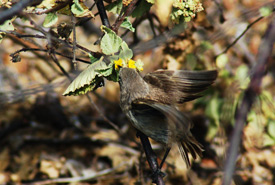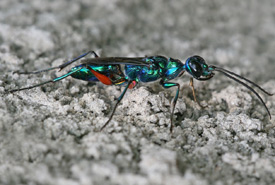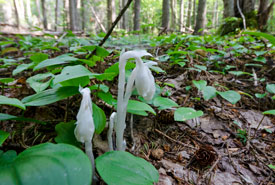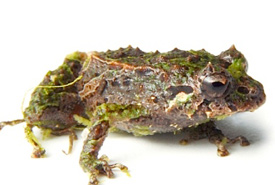Super cool species to know this Halloween

Vampire finch (Photo from Wikimedia Commons)
The leaves have changed, the air has cooled and the pumpkins have been carved. You know what that means — it’s Halloween! This spooky custom has always been my favourite. Growing up, I always took the opportunity to dress up as the monsters and creatures I saw in horror movies while trick-or-treating. What I didn’t realize is that some of these fictional monsters I had grown to love had super cool counterparts outside of the movies. The natural world is full of species with survival techniques and wacky adaptations. Check out these animals and plants found in habitats around the world worthy of a mention on this special day.
Blood-sucking birds
The first, and maybe the most, iconic monster of all is the vampire. Vampires exist, but they won’t be found in a castle in Transylvania. Instead, you can find these tiny vampires on an isolated, barren island in the Galapagos Islands, off the coast of Ecuador. The vampire finch has a diet of seeds, insects and, you guessed it, blood! These birds have developed a taste for blood by hopping onto larger birds, such as blue-footed booby, and pecking at their feathers. Their victims are often willing hosts, and may think that the finches are helping them by eating flies and ticks. Never mind fangs, watch out for those blood-pecking beaks!

Emerald cockroach wasp (Photo from Wikimedia Commons)
Zombie roaches
The un-dead have risen! Well, sort of. The emerald cockroach wasp, or jewel wasp, has the ability to turn its victim into a zombie. Unlike most parasitic wasps that simply immobilize, this wasp’s sting has the capability to manipulate the behaviour of its prey. The unfortunate victim in this situation is the common cockroach. The wasp’s wicked work begins by stinging its prey, leaving it with the ability to move, but taking away its ability to make its own decisions. The now “zombified” victim is led by the wasp to its lair, where it will drink the roach’s internal body fluids. This parasite wasp will continue the horror by laying eggs on the cockroach. Its larvae will eventually hatch and chew their way into the now-deceased cockroach, using its body as a personal cocoon. This terrifying act is an example of how neurotoxic chemicals can leave a species behaving like the living dead!

Ghost pipe, Holman's Island, PEI (Photo by Sean Landsman)
Phantom plants
There are ghosts lurking in the dark corners of Canadian forests — ghost plants that is. The ghostly white corpse plant, or Indian pipe, has some very ghoul-like characteristics. This plant is non-photosynthetic, contains no chlorophyll and is pure white in colour. Instead of relying on the sunlight for photosynthesis, the corpse plant relies on a large network of roots and associated fungi. This spooky plant then uses these systems to steal energy from the plants living around it. This process is called myco-heterotrophy, which is a type of symbiotic relationship where plants gets their food from parasitism instead of photosynthesis. So the next time you see a white apparition in the dark, look again. It may just be a corpse plant!

Mutable rain frog (Photo from Wikimedia Commons)
Howling "werefrogs"
In a small area of the cloud forest of Ecuador is where you will find this shapeshifting creature — and you don’t need a full moon to see it change. The recently discovered mutable rain frog has the unique ability to visibly change its appearance. This endangered amphibian can change the texture of its skin from smooth to spiny in a matter of seconds. Another peculiar characteristic that this little creature has is its notorious night-time vocalizations. Although they aren’t howling at the moon, they make a very distinct call in the dead of night. This is the first known vertebrate to be able to change its appearance in such a rapid timeframe.
It turns out the supernatural is much more natural than we realize. This Halloween, instead of watching monsters on screen or dressing up as one while trick-or-treating, try learning more about the amazing species that some of our fictional fearsome characters are inspired from.
Happy Halloween!


